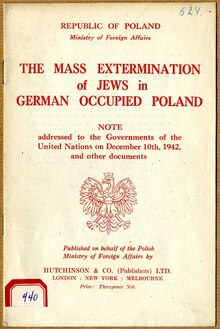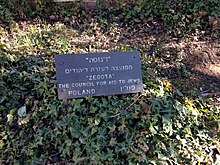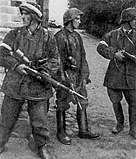| Revision as of 07:20, 1 June 2018 view sourceIcewhiz (talk | contribs)Extended confirmed users38,036 edits →Composition: per Misplaced Pages:Biographies of living persons/Noticeboard/Archive269#Żegota← Previous edit | Revision as of 16:59, 1 June 2018 view source GizzyCatBella (talk | contribs)Extended confirmed users, Pending changes reviewers, Rollbackers17,604 edits Restoring mass removal of sourced stable information (more than 4-6 weeks old) by Icewitz (without gaining a prior consensus to do so) plus adding another source to back it up.Tag: UndoNext edit → | ||
| Line 36: | Line 36: | ||
| Kossak-Szczucka was arrested in 1943 by the ] unaware of the extent of her underground activities.<ref name="Alvis"/> She initially wanted Żegota to become an example of a "pure Christian charity" and argued that the Jews had their own international charity organizations. She went on to act in the Social Self-Help Organization (''Społeczna Organizacja Samopomocy - SOS'') as a liaison between Żegota and Catholic convents and orphanages as well as other public orphanages, which jointly hid many Jewish children. Żegota's children's section was headed by ], a Polish social worker and activist, who was nominated for a ] before her death in 2008.<ref name=scity>{{cite book|author=Gunnar S. Paulsson|title=Secret City: The Hidden Jews of Warsaw, 1940-1945|url=https://books.google.com/books?id=vjJimC--9-kC&pg=PA269|year=2002|publisher=Yale University Press|isbn=978-0-300-09546-3|page=269}}</ref> | Kossak-Szczucka was arrested in 1943 by the ] unaware of the extent of her underground activities.<ref name="Alvis"/> She initially wanted Żegota to become an example of a "pure Christian charity" and argued that the Jews had their own international charity organizations. She went on to act in the Social Self-Help Organization (''Społeczna Organizacja Samopomocy - SOS'') as a liaison between Żegota and Catholic convents and orphanages as well as other public orphanages, which jointly hid many Jewish children. Żegota's children's section was headed by ], a Polish social worker and activist, who was nominated for a ] before her death in 2008.<ref name=scity>{{cite book|author=Gunnar S. Paulsson|title=Secret City: The Hidden Jews of Warsaw, 1940-1945|url=https://books.google.com/books?id=vjJimC--9-kC&pg=PA269|year=2002|publisher=Yale University Press|isbn=978-0-300-09546-3|page=269}}</ref> | ||
| According to a letter by Adolf Berman, the Jewish Secretary of Żegota and head of the Jewish National Committee, dated February 26, 1977, there were other activists who were especially meritorious. He mentioned theatre artist Prof. Maria Grzegorzewska, psychologist Irena Solska, Janina Buchholtz-Bukolska*, educator Irena Sawicka*, scouting activist Dr. Ewa Rybicka, school principal Irena Kurowska, Prof. Stanisław Ossowski and Prof. Maria Ossowska, zoo director Dr. Jan Żabiński* and his wife Antonina*, a writer Stefania Sempołowska, the unforgettable director of children's theatres Jan Wesołowski*, Sylwia Rzeczycka*, Maria Łaska, Maria Derwisz-Parnowska (later Kwiatowska*). Former Senator Zofia Rodziewicz, Zofia Derwisz-Latalowa, Dr. Regina Fleszar and others had great merits. Beside the university educated people there were members of the working-class like Waleria Malaczewska, Antonina Roguska, Jadwiga Leszczanin, Zofia Dębicka*, tailor Stanisław Michalski, farmers Kajszczak from Łomianki and Paweł Harmuszko, laborer Kazimierz Kuc and many others. Those with an asterisk (*) after their name have been recognized by ] as ] up to the end of 1999.<ref>Anna Poray, {{cite web |url=http://www.savingjews.org/righteous/rv.htm |title=Polish Righteous, Those Who Risked Their Lives; see: Rajszczak family |accessdate=2008-06-17 |deadurl=bot: unknown |archiveurl=https://web.archive.org/web/20080110231526/http://www.savingjews.org/righteous/rv.htm |archivedate=January 10, 2008 |df= }}, 2004.</ref> | |||
| ==Activities== | ==Activities== | ||
Revision as of 16:59, 1 June 2018
For other uses, see Żegota (disambiguation). The third anniversary of the Warsaw Ghetto Uprising with members of Żegota, Warsaw, April 1946. Seated, from right to left: Piotr Gajewski, Ferdynand Marek Arczyński, Władysław Bartoszewski, Adolf Berman and Tadeusz Rek The third anniversary of the Warsaw Ghetto Uprising with members of Żegota, Warsaw, April 1946. Seated, from right to left: Piotr Gajewski, Ferdynand Marek Arczyński, Władysław Bartoszewski, Adolf Berman and Tadeusz Rek | |
| Predecessor | Provisional Committee to Aid Jews |
|---|---|
| Formation | September 27, 1942; 82 years ago (1942-09-27) |
| Founder | Henryk Woliński, |
| Type | Underground organization |
| Purpose | Help and distribution of relief funds to Polish Jews in World War II |
| Headquarters | Warsaw |
| Location | |
| Region | occupied Poland |
| Key people | Henryk Woliński, Julian Grobelny, Ferdynand Arczyński, Zofia Kossak-Szczucka, Wanda Krahelska-Filipowicz, Adolf Berman, Leon Feiner, Władysław Bartoszewski |
"Żegota" Template:IPA-pol, also known as the "Konrad Żegota Committee", was a codename for the Polish Council to Aid Jews (Template:Lang-pl), an underground resistance organization in German-occupied Poland active from 1942 to 1945 that was part of the Polish Underground State.
Composition
The Council to Aid Jews, Żegota, was the continuation of an earlier secret organization set up for the purpose of rescuing Jews in German-occupied Poland, the Provisional Committee to Aid Jews (Tymczasowy Komitet Pomocy Żydom). The Provisional Committee was founded on 27 September 1942 by Zofia Kossak-Szczucka and Wanda Krahelska-Filipowicz ("Alinka"). It was made up mostly of Polish Catholic activists. Within a short time, the original Committee had 180 persons under its care, but was dissolved for political and financial reasons. Żegota was created to supersede it on December 4, 1942.
It is estimated that about half of the Jews who survived the Holocaust in occupied Poland were aided in some shape or form by Żegota founded in 1942. Żegota had around one hundred (100) cells, operating mostly in Warsaw where it distributed relief funds to about 3,000 Jews. The second-largest branch was in Kraków, and there were smaller branches in Wilno (Vilnius) and Lwów (L'viv). In all, 4,000 Jews received funds from Żegota directly, 5,600 from the Jewish National Committee and 2,000 from the Bund (because of overlaps, the total number of Jews helped by all three organizations in Warsaw was about 8,500). This aid reached about one-third of the Jews in hiding in Warsaw, but mostly not until late 1943 or 1944. The systematic killing of Jews began to take place, so it was hard to save Jews already in the ghetto. That is why they only protected Jews located in hiding in Poland. Zegota was supported by Polish Home Army which provided its facilities dedicated to forging German identitifcation papers

Żegota was the brainchild of Henryk Woliński of the Home Army (AK). From its inception, the elected General Secretary of Żegota was Julian Grobelny, an activist in prewar Polish Socialist Party. Its Treasurer, Ferdynand Arczyński, was a member of the Polish Democratic Party. They were also two of its most active workers. Members included Władysław Bartoszewski, later Polish Foreign Minister (1995, 2000). Żegota was the only Polish organization in World War II run jointly by Jews and non-Jews from a wide range of political movements. Structurally, the organization was formed by Polish and Jewish underground political parties.
Jewish organizations were represented on the central committee by Adolf Berman and Leon Feiner. The member organizations were the Jewish National Committee (an umbrella group representing the Zionist parties) and the Marxist General Jewish Labour Bund. Both Jewish parties operated independently also, using money from Jewish organizations abroad channelled to them by the Polish underground. They helped to subsidize the Polish branch of the organization, whose funding from the Polish government in exile (in London) reached significant proportions in the late Spring of 1944. On the Polish side, political participation included the Polish Socialist Party as well as Democratic Party (Stronnictwo Demokratyczne) as well as Catholic Front Odrodzenia Polski (the Front for the Rebirth of Poland) led by Kossak-Szczucka and Witold Bieńkowski, editors of its underground publications. The right-wing National Party (Stronnictwo Narodowe) refused to participate.
Kossak-Szczucka was arrested in 1943 by the Gestapo unaware of the extent of her underground activities. She initially wanted Żegota to become an example of a "pure Christian charity" and argued that the Jews had their own international charity organizations. She went on to act in the Social Self-Help Organization (Społeczna Organizacja Samopomocy - SOS) as a liaison between Żegota and Catholic convents and orphanages as well as other public orphanages, which jointly hid many Jewish children. Żegota's children's section was headed by Irena Sendler, a Polish social worker and activist, who was nominated for a Nobel Prize before her death in 2008.
According to a letter by Adolf Berman, the Jewish Secretary of Żegota and head of the Jewish National Committee, dated February 26, 1977, there were other activists who were especially meritorious. He mentioned theatre artist Prof. Maria Grzegorzewska, psychologist Irena Solska, Janina Buchholtz-Bukolska*, educator Irena Sawicka*, scouting activist Dr. Ewa Rybicka, school principal Irena Kurowska, Prof. Stanisław Ossowski and Prof. Maria Ossowska, zoo director Dr. Jan Żabiński* and his wife Antonina*, a writer Stefania Sempołowska, the unforgettable director of children's theatres Jan Wesołowski*, Sylwia Rzeczycka*, Maria Łaska, Maria Derwisz-Parnowska (later Kwiatowska*). Former Senator Zofia Rodziewicz, Zofia Derwisz-Latalowa, Dr. Regina Fleszar and others had great merits. Beside the university educated people there were members of the working-class like Waleria Malaczewska, Antonina Roguska, Jadwiga Leszczanin, Zofia Dębicka*, tailor Stanisław Michalski, farmers Kajszczak from Łomianki and Paweł Harmuszko, laborer Kazimierz Kuc and many others. Those with an asterisk (*) after their name have been recognized by Yad Vashem as Righteous Among the Nations up to the end of 1999.
Activities

Żegota helped save some 4,000 Polish Jews by providing food, medical care, relief money, and false identity documents for those hiding on the so-called "Aryan side" of German-occupied Poland. Most of its activity took place in Warsaw. The Jewish National Committee had some 5,600 Jews under its care and the Bund, an additional 1,500, but the activities of the three organizations overlapped to a considerable degree. Between them, they were able to reach some 8,500 of the 28,000 Jews hiding in Warsaw, and perhaps another 1,000 Jews hiding elsewhere in Poland.
Help in the forms of money, food, and medicines was organised by Żegota for the Jews in several forced labour camps in Poland as well. Financial aid as well as forged identity documents was procured for those hiding on the "Aryan side". The escape of Jews from ghettos, camps, and deportation trains occurred mostly spontaneously through personal contacts, and most of the help that was extended to Jews in the country was similarly personal in nature. Because Jews in hiding preferred to remain well-concealed, Żegota had trouble finding them. Its activities therefore did not develop on a larger scale until late in 1943.
The German occupying forces made concealing Jews a crime punishable by death for every Pole (the head of the household and his or her entire family) living in a house where Jews were discovered. Over 700 Polish heroes, murdered by Germans as a result of helping and sheltering their Jewish neighbors, were posthumously awarded the title, Righteous Among the Nations, by Yad Vashem, but these seven hundred were only a small percentage of thousands of Poles reportedly executed by the Nazis for aiding Jews: "the number of Poles who perished at the hands of the Germans for aiding Jews" may have been as high as fifty thousand. "Władysław Bartoszewski, who worked for Żegota during the war estimates that 'at least several hundred thousand Poles... participated in various ways and forms in the rescue action .' Recent research suggests that a million Poles were involved" in giving aid, "but some estimates go as high as three million" for those who were passively protective.
Żegota played a large part in placing Jewish children with foster families, public orphanages, and church orphanages and convents. Foster families had to be told that the children were Jewish, so that they could take appropriate precautions, especially in the case of boys (Jewish boys, unlike most Poles, were circumcised). Żegota sometimes paid for the children's care. In Warsaw, Żegota's children department, headed by Irena Sendler, cared for 2,500 of the 9,000 Jewish children smuggled out of the Warsaw Ghetto. Sendler attempted to return these children to their parents at the end of World War II, but almost all the parents had died at Treblinka.
Medical attention for the Jews in hiding was also made available through the Committee of Democratic and Socialist Physicians. Żegota had ties with many ghettos and camps. It also made numerous efforts to induce the Polish Government in Exile and the Delegatura to appeal to the Polish population to help the persecuted Jews.
Postwar recognition

In 1963 Żegota was memorialised in Israel with the planting of a tree in the Avenue of the Righteous at Yad Vashem. Władysław Bartoszewski was present.
See also
- Rescue of Jews by Poles during the Holocaust
- History of the Jews in Poland
- Timeline of Jewish-Polish history
- Polish resistance movement in World War II
- Occupation of Poland (1939–45)
Notes and references
| Part of a series on the |
| Polish Underground State |
|---|
 History of Poland 1939–1945 History of Poland 1939–1945 |
| Authorities |
|
Political organizations Major parties Minor parties Opposition |
|
Military organizations Home Army (AK) Mostly integrated with Armed Resistance and Home Army Partially integrated with Armed Resistance and Home Army
Non-integrated but recognizing authority of Armed Resistance and Home Army Opposition |
| Related topics |
Specific
- ^ Gunnar S. Paulsson (2002). Secret City: The Hidden Jews of Warsaw, 1940-1945. Yale University Press. p. 269. ISBN 978-0-300-09546-3.
- ^ Yad Vashem Shoa Resource Center, Zegota
- Władysław Bartoszewski: środowisko naturalne korzenie Michal Komar, Wladyslaw Bartoszewski Świat Ksia̜żki, page 238, 210
- Tadeusz Piotrowski (1997). "Assistance to Jews". Poland's Holocaust. McFarland & Company. p. 118. ISBN 0-7864-0371-3.
{{cite book}}: Cite has empty unknown parameter:|chapterurl=(help) - Żydzi w Polsce: dzieje i kultura : leksykon Jerzy Tomaszewski, Andrzej Żbikowski Wydawnictwo Cyklady, 2001, page 552
- Encyclopedia of the Holocaust, volumes 3-4 Israel Gutman Macmillan Library Reference USA, page 1730
- ^ Robert Alvis (2016). White Eagle, Black Madonna: One Thousand Years of the Polish Catholic Tradition. Oxford University Press. pp. 212, 214. ISBN 0823271730.
- Anna Poray, "Polish Righteous, Those Who Risked Their Lives; see: Rajszczak family". Archived from the original on January 10, 2008. Retrieved 2008-06-17.
{{cite web}}: Unknown parameter|deadurl=ignored (|url-status=suggested) (help), 2004. - Andrzej Sławiński, Those who helped Polish Jews during WWII. Translated from Polish by Antoni Bohdanowicz. Article on the pages of the London Branch of the Polish Home Army Ex-Servicemen Association. Last accessed on March 14, 2008.
- Chaim Chefer, Righteous of the World: Polish citizens killed while helping Jews During the Holocaust
- Ron Riesenbach, The Story of the Survival of the Riesenbach Family
- ^ Richard C. Lukas, Out of the Inferno: Poles Remember the Holocaust University Press of Kentucky 1989 - 201 pages. Page 13; also in Richard C. Lukas, The Forgotten Holocaust: The Poles Under German Occupation, 1939-1944, University Press of Kentucky 1986 - 300 pages.
General
- Various authors. Andrzej Krzysztof Kunert, Andrzej Friszke (ed.). "Żegota" Rada Pomocy Żydom 1942–1945 (in Polish). Warsaw: Rada Ochrony Pamięci Walk i Męczeństwa. ISBN 83-916666-0-3.
{{cite book}}: Cite has empty unknown parameter:|chapterurl=(help) - Various authors (2003). Joshua D. Zimmerman (ed.). Contested Memories: Poles and Jews During the Holocaust and Its Aftermath. Rutgers University Press. p. 336. ISBN 0-8135-3158-6.
{{cite book}}: Cite has empty unknown parameter:|chapterurl=(help) - MS Nechama Tec (1986). When Light Pierced the Darkness: Christian Rescue of Jews in Nazi-occupied Poland. Oxford: Oxford University Press. ISBN 0-19-505194-7.
{{cite book}}: Cite has empty unknown parameter:|chapterurl=(help) - Tadeusz Piotrowski (1997). Poland's Holocaust. McFarland & Company. ISBN 0-7864-0371-3.
{{cite book}}: Cite has empty unknown parameter:|chapterurl=(help) - Gunnar S. Paulsson. Secret City: The Hidden Jews of Warsaw, 1940-1945. Yale: Yale University Press. p. 2002. ISBN 0-300-09546-5.
{{cite book}}: Cite has empty unknown parameter:|chapterurl=(help) - Irene Tomaszewski; Tecia Werbowski (1994). Zegota: The Rescue of Jews in Wartime Poland. Montreal: Price-Patterson.
{{cite book}}: Cite has empty unknown parameter:|chapterurl=(help) - Irene Tomaszewski; Tecia Werbowski (1994). Zegota: The Council to Aid Jews in Occupied Poland 1942-1945. Price-Patterson. ISBN 1-896881-15-7.
{{cite book}}: Cite has empty unknown parameter:|chapterurl=(help)
External links
- Excerpts from the book Żegota by Irena Tomaszewska & Tecia Werbowski
- Zegota - book and documentary film